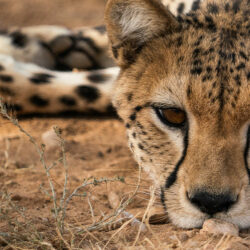Dr. Laurie Marker’s Opening Speech at the Global Cheetah Summit
-

- by CCF Staff February 7, 2024

As the fastest land mammal, the cheetah is a species with an interesting evolutionary history, as well as a long history with humans and an icon of the arid lands. The cheetah is a wide-ranging species that occurs at much lower densities than that recorded for most other large felids. While the human population continues to grow, cheetah numbers have declined at an alarming state and climate change will affect the situation even more drastically in the very near future.
Today the total free-ranging population is estimated at 7100 adults and adolescents distributed across 33 populations in 19 African countries and Iran. Most populations are found in some of the most arid landscapes living near some of the poorest communities in the world. Cheetah populations continue to decline despite the best efforts of a small global network of dedicated researchers and conservationists.
With all but two populations below the numbers needed for long-term viability, the species’ survival across its current range requires action now, and at a much greater scale than is currently underway. Solving the cheetah conservation crisis requires addressing a complex web of social, economic, and environmental issues while stabilizing (and eventually increasing) viable cheetah populations throughout their range.
The immediate threats to cheetahs are habitat loss and fragmentation, loss of prey base, direct persecution due to human-carnivore conflict, and illegal trade; with climate change and human population growth exacerbating these threats at an accelerating rate. The species’ documented genetic uniformity could compound these threats in the smaller, isolated populations, which will continue to decline and disappear if conservation actions are not implemented.
Conservationists, governments, and businesses must work globally to develop solutions and initiatives to save the cheetah. There is a need for greater support from all stakeholders and for increased funding and resources. There is a need for efficient monitoring and research, and a heightened level of cooperation among conservation groups with similar interests. Cheetah survival is in the hands of humans.
The participants of the 2024 Global Cheetah Summit realize the problems and commit to the following to ensure cheetahs will be present in the wild for future generations
Community Engagement:
We must engage communities and landowners through education, awareness raising, and human–cheetah coexistence initiatives to contribute to the establishment of positive attitudes and behaviors that can benefit predator conservation. Initiatives that link cheetah conservation to financial benefits or community resources must be adopted. Aspects around ecotourism, where appropriate, can provide support through employment (e.g., safari guides, camp staff), as well as support services from the wider community.
However, the issue of human–carnivore coexistence is complex and achieving cheetah conservation in human dominated landscapes will require an integrated approach, which promotes economic development in an environmentally sustainable fashion.
Government Support:
As cheetahs are largely found outside of protected areas, their conservation depends on cooperation and coordination between governments and citizens across a matrix of privately owned and public landscapes. To succeed, cheetah conservation needs to be driven from within the range states where cheetahs are resident.
We must support adoption of conservation-focused law and policies around issues such as land use, poverty alleviation, sustainable use of wildlife (e.g., game ranching, hunting, tourism), illegal trade, conservancies, bushmeat hunting, and ecologically friendly livestock and game management.
We must have government support to conserve natural resources and wildlife in areas lacking the formal structure of protection such as parks and reserves. We will provide support to capacity building among decision-makers and wildlife professionals to develop the knowledge and skills necessary to implement policies that affect the cheetah’s survival.
Illegal Wildlife Trafficking:
Standard approaches of using rangers and government officials to prosecute traffickers caught in the act are working to some degree. However, for every trafficker that is caught, there are more to take their place. We must encourage governmental support for harsher penalties for those found guilty of illegal trafficking. If the threat of longer-term incarceration is more detrimental to their family than the money provided by the illegally trafficked cheetah, they may reconsider.
The only way to effectively reduce the sheer number of cheetahs trafficked is to reduce the demand for wild cubs. We must stop the rate at which cheetahs are being taken from the wild. Perhaps those who want a pet cheetah could be invited to join our cause to save the wild cheetah and become Conservation Ambassadors.
Maintaining Functional Ecosystems:
We must maintain and recover functional ecosystems, promoting conservation at all levels including intact guilds of large carnivores and their prey, along with the structural and functional biodiversity. The majority of cheetahs (78%) live on nonprotected land; and protected areas are generally too small to support cheetah populations without connectivity to cheetahs outside of their boundaries.
To achieve the impact and scale needed for cheetah conservation, it is imperative that we collaborate under a multispecies, and interdisciplinary approach.
As the threats are similar for other large African carnivores, in terms of habitat loss and persecution, multi-species approaches enable the expansion of the scale, scope, and efficiency of conservation programs, as with the integration of cheetah and African wild dog conservation.
Interdisciplinary approaches will integrate cheetah conservation with grassland management, land use planning, the conservation of other endemic species, and the economic development of key areas.
Resources
In the near-term, the available funding and resources to devote to conservation actions are likely to remain limited and highly competitive. Prioritization of conservation efforts may therefore be required to focus resources on key issues, preventing scarce resources being spent on what cannot be saved.
We must draft a set of rational criteria, identifying those areas of conservation priority (e.g., key populations or habitat corridors), as well as programs likely to have the greatest impact and likelihood of success. We must share the limited resources using multispecies and interdisciplinary approaches as one way to maximize available funding.
We must secure funds beyond donor-based contributions. Resources must be drastically increased over a longer time frame, more predictably than is currently available, to implement the conservation initiatives at the scale needed to conserve the remaining cheetah populations.
Related Reading
-
November 15, 2023
Double Your Gift – Home Range for the Holidays 2023 -
December 7, 2022
CCF Wins Gold Prize at the 2022 Namibia Tourism Expo




